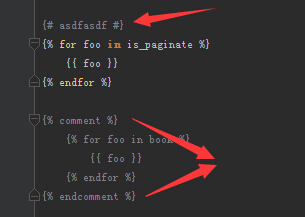Django入門:使用技巧【後續會一直新增】
from django.db import models
class Test(models.Model):
test = models.ChartField()
#上面的連結就是有關所有models後的所有欄位及解釋django註釋
{#。。。。。#}
{% comment %}
django過濾器
{{ name | lower }},將name變數的值轉化成小寫; {{ my_text|escape|linebreaks }} ,轉移文字為html,再轉化每行到
需要引數的過濾器:{{ bio|truncatewords:”30” }} 這個將顯示變數 bio 的前30 個詞。過濾器引數總是使用雙引號標識。
locals()
def method(request):
now = datetime.datetime.now()
return render_to_response('index.html',locals())
return render_to_response('index.html',{'time':now}) #兩種寫法都可以,locals() 將區域性變數都組織成dict 格式,懶人專用{{block.super}}獲取父級頁面對應標籤內容
(1){%block title%}本頁面的title{%endblock%}
(2)一個頁面中不要出現多個同名的block,否則模板引擎解析將混亂
{% extends ‘base.html’ %}
(1)extends 標記只能放在最頂部,否則失效
(2)extends 後面跟:一個字串或者是一個變數
(3)extends 對傳入的模板名稱,載入方式和get_template(),render_to_response()相同,都是以settings中TEMPLATES_DIRS 為字首
django modles之objects資料管理器(資料篩選)
(1)equal
Author.objects.filter(name=’kevin’) 對應的sql語句是:select name,…. where name=’kevin’,為什麼不用select *,而具體指明欄位呢,在python界裡有一信條:“ 明確比不明確來的好 ”
filter(name=’kevin’,[key=value])可以傳多個類似的引數,相應會生成多個and 條件後查詢
(2)__like, __in,__iexact, __exact,__contains,__gt,__gte,__lt,__lte,__startswith,__istartswith(sqlite中使用),__endswith,__iendswith(sqlite中使用),__range(start,end)
Author.objects.filter(name__contains=’kevin’) ==>select name,…. where name like ‘%kevin%’
Author.objects.filter(name__in=[‘kevin’,’miao’]) ==>select name,…. where name in(‘kevin’,’miao’)
Author.objects.filter(name__iexact=’kevin’)==>select name,…. where name like ‘kevin’)
Author.objects.filter(name__exact=’kevin’)==>select name,…. where name = ‘kevin’)
Entry.objects.filter(id__gt=4) ==> SELECT … WHERE id > 4;
Entry.objects.filter(id__gte=4) ==> SELECT … WHERE id >= 4;
Entry.objects.filter(id__lt=4) ==> SELECT … WHERE id < 4;
Entry.objects.filter(id__lte=4) ==> SELECT … WHERE id <= 4;
Entry.objects.filter(headline__startswith=’Will’) ==> SELECT … WHERE headline LIKE ‘Will%’;
Entry.objects.filter(headline__endswith=’Will’) ==> SELECT … WHERE headline LIKE ‘%Will’;
start_date=datetime.date(2005,1,1)
end_date=datetime.date(2005,3,31)
Entry.objects.filter(pub_date__range=(start_date,end_date))
SELECT … WHERE pub_date BETWEEN ‘2005-01-01’ and ‘2005-03-31’;
https://docs.djangoproject.com/en/dev/ref/models/querysets/#std:fieldlookup-exact
(5)order_by 排序
Author.objects.all().order_by('name') ,‘ -name ’方序(desc)#即為反序排列
可以在模型中定義內部類Meta,並指明ordering,預設情況下將使用此排序:
def Author(models.Model):
name = CharField(max_length=30)
#................................................................
def __str__(self):
return self.name
class Meta:
ordering = ["name"] (6)限制返回的資料
Author.objects.all()[0] ===>> select name,…. from Author limit 1
django完整流程
【轉載地址】
(一) 初始化測試執行環境
import os;
import sys;
sys.path.append("G:/pydev/mysite2") # 需要修改
os.environ.setdefault("DJANGO_SETTINGS_MODULE", "mysite2.settings") # 需要修改
from qi.models import *
Catalog.objects.all()
Catalog.objects其中Catalog.objects是django.db.models.manager.Manager型別的對物件,Manager是模型(Model)訪問資料的操作介面。
技巧
import os;
import sys;
sys.path.append(“G:/pydev/mysite2”) # 需要修改
os.environ.setdefault(“DJANGO_SETTINGS_MODULE”, “mysite2.settings”) # 需要修改
可以放到 Python27\Lib\site-packages\sitecustomize.py 檔案中這樣可以不用每次都輸
由於目前尚無法解決命令列的字符集設定問題,所有以下的例子都是在程式檔案中編寫並執行。
在mysite2/qi(應用程式目錄)目錄下新建mytest.py,編寫程式碼,並在eclipse下執行。
(二)使用get讀取物件
print(Catalog.objects.get(id=1));
print(Catalog.objects.get(name=”根目錄”));
print(Catalog.objects.get(id=1, name=”根目錄” , state=’A’));
使用get獲取物件的時候如何,如果物件不存在或符合條件的物件超過1個,都將出現異常。
(三)使用filter和exclude
print(Catalog.objects.filter(code__startswith=”c”, state=”A”));
print(Catalog.objects.filter(code__startswith=”c”, state=”A”).filter(id = 42));
print(Catalog.objects.filter(code__startswith=”c”, state=”A”).exclude(id = 42));
print(Catalog.objects.filter(code__icontains=”er”)) # 包含
print(Catalog.objects.filter(code__icontains=”i”)) # 包含
其中”__”表示”.”的作用,這個由django來轉義。
使用filter可以允許沒有返回資料,或者多個返回資料。
filter和exclude可以串聯使用
(四) 簡單日期操作
from datetime import datetime;
from datetime import date;
print(Catalog.objects.filter(create_date__year=2013)); # 時間的年份為2013年
print(Catalog.objects.filter(create_date__gte=date.today())); # 時間大於今天
print(Catalog.objects.filter(create_date__gte=datetime(2013, 5, 23))); # 時間大於2013年5月23日
print(Catalog.objects.filter(create_date__lte=’2013-05-23’)) # 時間小於2013年5月23日
(五)exists使用
print(Catalog.objects.filter(pk=1).exists())
(六) 用索引器限制記錄的數量
print(Catalog.objects.all())
print(Catalog.objects.all()[:5])
print(Catalog.objects.all()[0:5])
print(Catalog.objects.all()[3:5])
print(Catalog.objects.all()[1:6:2])
print(Catalog.objects.order_by(‘ord’)[0]) # 沒有找到資料會報異常:IndexError: list index out of range
print(Catalog.objects.order_by(‘ord’)[0:1]) # 注意該方法和上1行,一樣是取第1條記錄,但是如果沒有找到資料,這樣寫法不會報異常
print(Catalog.objects.order_by(‘-ord’)[0]) # 倒序排序,取最後一個
(七)exact和iexact使用
print(Catalog.objects.filter(code__exact=”public”));
print(Catalog.objects.filter(code__iexact=”PUBLIC”)); # 大小寫不敏感
print(Catalog.objects.filter(code__exact=”PUBLIC”)); # 查無資料
預設情況下執行的是寫code=”public”等價於code__exact=”public”。
(八)contains和icontains
print(Catalog.objects.filter(code__contains=”er”));
print(Catalog.objects.filter(code__icontains=”ER”)); # 大小寫不敏感
print(Catalog.objects.filter(code__contains=”ER”)); # 查無資料
code__contains=”er”相當於SELECT … from qi_catalog WHERE code LIKE ‘%er%’;
(九)startswith和endswith
print(Catalog.objects.filter(code__startswith=”c”));
print(Catalog.objects.filter(code__endswith=”e”));
print(Catalog.objects.filter(code__istartswith=”C”)); # 大小寫不敏感
print(Catalog.objects.filter(code__iendswith=”E”)); # 大小寫不敏感
(十)一對多物件的訪問
print(Catalog.objects.filter(parent__name=”根目錄”)) # parent = models.ForeignKey(‘self’); # 訪問根目錄下的所有子目錄
(十一)多對對關係
class Catalog(StateObject)
... ...
papers = models.ManyToManyField(Paper, through='CatalogPaper')
... ...
print(Catalog.objects.filter(papers__name__startswith="公益")) # 通過papers變數訪問
print(Catalog.objects.filter(catalogpaper__paper__name__startswith="公益"));
# 通過隱含的多對多關係,以上方式特別注意Catalog沒有catalogpaper欄位,這是通過隱含多對多關係訪問。同樣的方法也可以用paper物件來訪問catalog,如下:
print(Paper.objects.filter(catalogpaper__catalog__name="公益"))這種方式訪問關聯物件進行條件組合要注意,串聯filter或exclude是,和直接使用(,..,..)表達是有語義不同的,請注意一下兩種寫法,是不同的:
print(Catalog.objects.filter(catalogpaper__paper__name=”公益問卷1” , catalogpaper__paper__name__startswith=’公益問卷2’)) # 不會用資料返回,因為不可能有一個目錄下包含一個問卷名字叫做”公益問卷1”且同時名字又以“公益問卷2”開頭的。
print(Catalog.objects.filter(catalogpaper__paper__name=”公益問卷1”).filter(catalogpaper__paper__name=’公益問卷2’)) # 有可能查到資料,此語義為找一個目錄,其下既有一個名為“公益問卷1”的問卷,又有一個以“公益問卷2”開頭的問卷(實際上是兩個問卷)。
通過xxxx_set訪問多對多關係
c = Catalog.objects.get(id=41);
cp = c.catalogpaper_set.all();
for p in cp :
print(p.paper.name)
注意:django中的帶擴充套件屬性的多對多關係,實際上是用一對多的關係實現的,所以我們實際上也可以用這種方法訪問多對多關係
(十二)isnull使用
print(Catalog.objects.filter(parent__isnull=True))
未完待續
(十三)使用F()
可以使用F()來在等號右邊引用物件查詢中的欄位,但是此時似乎不能用使用startswith,contains等關聯詞,但是可以用__lt,__lte,__gt,__gte等。
from django.db.models import F;
print(Catalog.objects.filter(name=F(‘name’)))
思考:這裡在等號的右邊不能使用“xx__xxx__xxx”這樣的方式來表示物件的對應屬性,應為在等號左邊python當成是區域性變數的定義,所以怎麼寫都沒有關係。是如果在等號右邊,要嘛是一個已定義變數,要嘛是一個數值或字串。當然也不能使用字串來表示物件的屬性,因為會於字串作為比較表示式的情況出現語言混亂,所以django才增加了一個叫做F()的類,解決這樣的問題。
print(Catalog.objects.filter(name__startswith=F(‘name’))) # 這個會報django.db.utils.DatabaseError: ORA-00909: invalid number of arguments。目前還不知道願原因。
(十四)in 的使用
print(Catalog.objects.filter(name__in=[“商業”,”社會”]))
(十五)欄位查詢關鍵字彙總
exact, iexact, contains, icontains, startswith, istartswith, endswith, iendswith
lt(less than),gt(great than),lte(less than or equal),gte(great than or equal)
in
(十六)快取機制
# 以下語句要查詢兩次資料庫
print([c.code for c in Catalog.objects.all()])
print([c.name for c in Catalog.objects.all()])
# 以下語句可以用上django的快取機制,只用訪問一次資料
cl = Catalog.objects.all();
print([c.code for c in cl])
print([c.name for c in cl])
# 在物件查詢集中使用資料索引要格外小心,因為每次索引都會訪問1次資料庫,即使是訪問同一個元素。注意如下語句:
cl = Catalog.objects.all();
cl[1]; # 訪問1次資料庫
cl[1]; # 在訪問1次資料庫
#最好是把所有資料,先遍歷一邊,在進行訪問:
cl = Catalog.objects.all();
[c.code for c in cl]
cl[1]; # 從快取讀資料
cl[1]; # 從快取讀資料
# 以下四種方法將物件集放進快取
[c for c in queryset]
bool(queryset)
c in queryset
list(queryset)存在疑問:
1、如何將字串屬性定義成非空null=False 和blank = False似乎都不生效
不帶擴充套件資訊的多對多關係的操作
beatles.members.add(john)
beatles.members.create(name=”George Harrison”)
beatles.members = [john, paul, ringo, george]
清除關係,是刪除關係還是刪除資料?
beatles.members.clear()
資料篩選
>>> Group.objects.filter(members__name__startswith='Paul')
[]
篩選
# Find all the members of the Beatles that joined after 1 Jan 1961
>>> Person.objects.filter(
... group__name='The Beatles',
... membership__date_joined__gt=date(1961,1,1))
[篩選 : 如果 關係R=A->B 如果重複新增R’=A->B 不知會出現什麼情況?
>>> ringos_membership = Membership.objects.get(group=beatles, person=ringo)
>>> ringos_membership.date_joined
datetime.date(1962, 8, 16)
>>> ringos_membership.invite_reason篩選
>>> ringos_membership = ringo.membership_set.get(group=beatles)
>>> ringos_membership.date_joined
datetime.date(1962, 8, 16)
>>> ringos_membership.invite_reason
u'Needed a new drummer.'直接執行sql語句
Person.objects.raw(‘SELECT id, first_name, last_name, birth_date FROM myapp_person’)
參考:https://docs.djangoproject.com/en/1.5/topics/db/sql/

